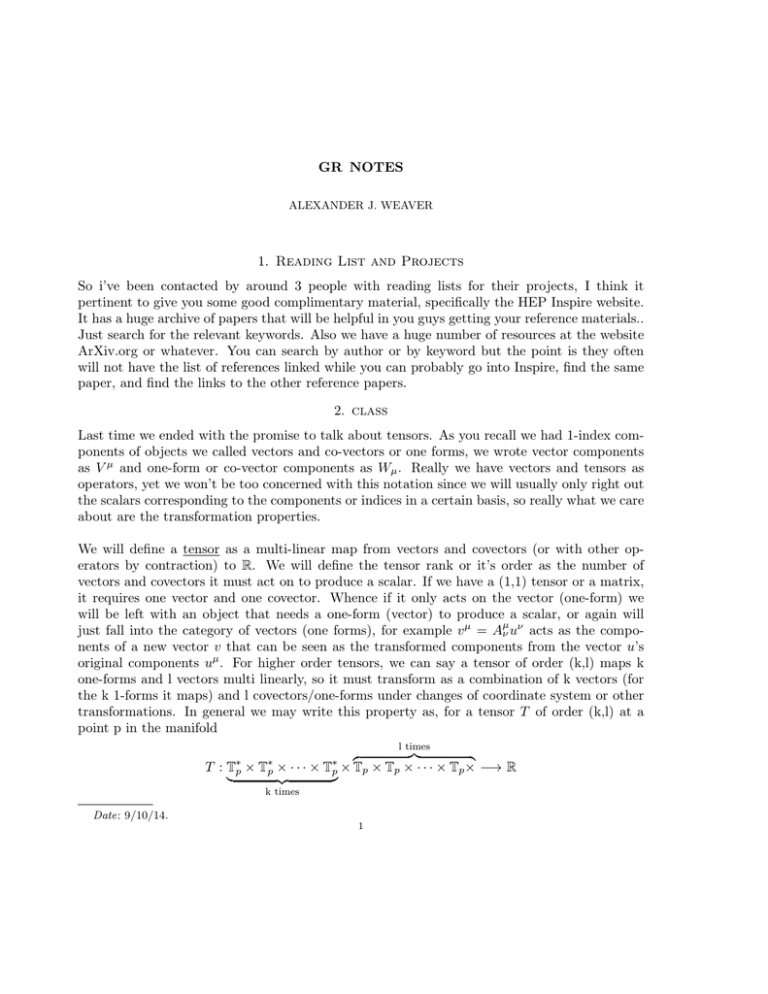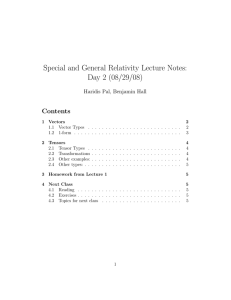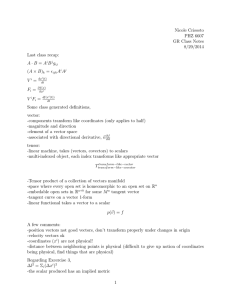GR NOTES 1. Reading List and Projects
advertisement

GR NOTES
ALEXANDER J. WEAVER
1. Reading List and Projects
So i’ve been contacted by around 3 people with reading lists for their projects, I think it
pertinent to give you some good complimentary material, specifically the HEP Inspire website.
It has a huge archive of papers that will be helpful in you guys getting your reference materials..
Just search for the relevant keywords. Also we have a huge number of resources at the website
ArXiv.org or whatever. You can search by author or by keyword but the point is they often
will not have the list of references linked while you can probably go into Inspire, find the same
paper, and find the links to the other reference papers.
2. class
Last time we ended with the promise to talk about tensors. As you recall we had 1-index components of objects we called vectors and co-vectors or one forms, we wrote vector components
as V µ and one-form or co-vector components as Wµ . Really we have vectors and tensors as
operators, yet we won’t be too concerned with this notation since we will usually only right out
the scalars corresponding to the components or indices in a certain basis, so really what we care
about are the transformation properties.
We will define a tensor as a multi-linear map from vectors and covectors (or with other operators by contraction) to R. We will define the tensor rank or it’s order as the number of
vectors and covectors it must act on to produce a scalar. If we have a (1,1) tensor or a matrix,
it requires one vector and one covector. Whence if it only acts on the vector (one-form) we
will be left with an object that needs a one-form (vector) to produce a scalar, or again will
just fall into the category of vectors (one forms), for example v µ = Aµν uν acts as the components of a new vector v that can be seen as the transformed components from the vector u’s
original components uµ . For higher order tensors, we can say a tensor of order (k,l) maps k
one-forms and l vectors multi linearly, so it must transform as a combination of k vectors (for
the k 1-forms it maps) and l covectors/one-forms under changes of coordinate system or other
transformations. In general we may write this property as, for a tensor T of order (k,l) at a
point p in the manifold
l times
T :
T∗p
|
×
T∗p
z
T∗p × Tp
× ··· ×
{z
}
k times
Date: 9/10/14.
1
}|
{
× Tp × · · · × Tp × −→ R
Where Tp is the tangent space at p in the manifold (where the vectors live) and T∗p is the
cotangent space, where the one-forms or covectors (or dual vectors) live. Technically, the
structure of this is that this mapping is more specifically a ring homomorphism from
l times
T :
T∗p
|
⊗
T∗p
z
T∗p ⊗ Tp
⊗ ··· ⊗
{z
}
}|
{
⊗ Tp ⊗ · · · ⊗ Tp ⊗ −→ R
k times
where the ⊗ stands for the multilinear tensor product, which gives the tensor the structure of
a member of the dual space of this tensor product space, or being in other words the sum of
elements with components having the form V1 ⊗ V2 ⊗ · · · Vk ⊗ U 1 ⊗ U 2 · · · ⊗ U l where Vi ei are
elements of the dual or cotangent space and U j ej are the elements of the tangent vector space.
The tensor product, being bilinear, has the properties:
(av1 + bu1 ) ⊗ (cv2 + du2 ) = (ac)(v1 ⊗ v2 ) + (ad)(v1 ⊗ u2 ) + (bc)(u1 ⊗ v2 ) + (bd)(u1 ⊗ u2 )
∀v1 , v2 , u1 , u2 in our vector space and all scalars a, b, c, d ∈ R. This can be extrapolated to
higher tensor products.
Now we have several types of operations between tensors, one is contraction where the tensors
act on the indices of the other tensor to map them to R, which for tensors with components
in a certain basis Tµ···αν···γ and Aµ···αν···γ we could contract like indices to get a scalar for that
induce
Tµ···αν···γ Aγ···βα···λ
where we add by einstein notation and reduce the rank we see by one covector (covariant)
index and one vector (contravariant) index. We can also form an outer product T ⊗ A with
components Tµ···αν···γ Aζ···βθ···λ which we see as an operator acting on the same number of vectors
and convectors as both tensors did separately. We have already been dealing with one tensor,
the metric tensor which we had
l(v) = gµν v µ v ν
or in other words this is a rank two tensor that acts on vectors to produce the length of the
vector. However remember, contracting a tensor only partially leaves the rest of it’s indices still
as objects, which means we could act on a single vector with g and be given back something
that still needs a vector to produce a scalar, or in other words g(v, −) where only v has been
acted on is actually a one form. In general the corresponding one form produced specifically
with the contraction of the metric is given the same symbol, even though it is now a one form.
This can be written as an object with components
vµ = gµν v ν
Similarly using the inverse of g, the contravarient formulation, we see
v µ = δνµ v ν = g µγ gγν v ν = g µγ (gγν v ν )
= g µγ vγ
2
or in other words we see we have the same relation, we create a vector from a covector by acting
on it with the inverse of the metric to get vector or contravarient form of the operator with
contravarient indices
wν = g νµ wµ
where wµ were the µ’th coefficients of the one-form/covector w.
We can now examine a class of tensors that g our metric tensor fell into. We noticed that
gµν wµ v ν = w · v = v · w = gµν v µ wν = gνµ wµ v ν
=⇒ (gµν − gνµ )wµ v ν = 0
for any vectors v and w
or in other words gνµ = gµν . So the metric is symmetric in it’s indices, and for any two index
tensor T = Tµν we can write Tµν = 12 [(Tµν + Tνµ ) + (Tµν − Tνµ )] = TS + TA or the symmetric
and antisymmetric portion. If the tensor is symmetric, as g is, the second portion is just zero,
while if it is anti-symmetric then the first part is zero.
We can generalize this to the symmetric tensors and antisymmetric tensors, where the symmetric
form of a tensor is displayed as
1 X
Tσ(µ···α)
T(µ···α) =
n!
all perm.σ
while the antisymmetric case is written as
1 X
T[µ···α] =
n!
sgn(σ) ∗ Tσ(µ···α)
all perm.σ
Specifically for the rank 3 case we have
1
TS = T(µνγ) = (Tµνγ + Tµγν + Tνµγ + Tνγµ + Tγµν + Tγνµ )
6
while
1
TA = T[µνγ] = (Tµνγ − Tµγν − Tνµγ + Tνγµ + Tγµν − Tγνµ )
6
3




